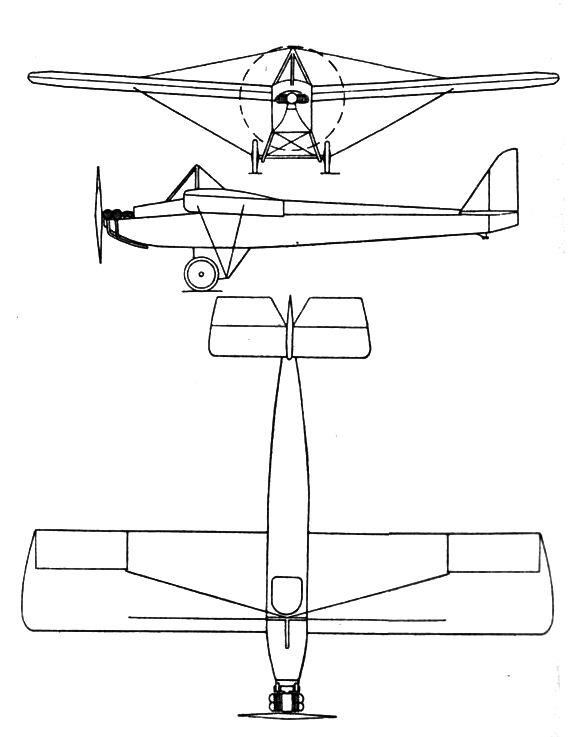
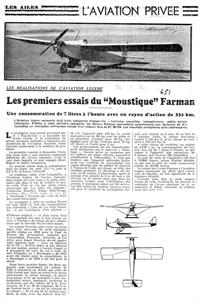
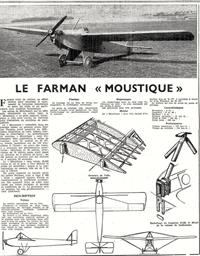
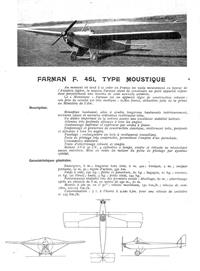
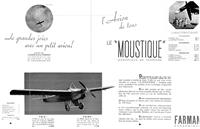
The original Moustique, later known as the Moustique I, was a shoulder wing monoplane. The wing was rectangular in plan, fabric covered and was wired braced from above and below. The upper wires were attached to a king post protruding from the raised, curved decking ahead of the cockpit and lower wires went to the undercarriage structure. The wings carried full span ailerons.
Behind the cockpit the fuselage, which reached up only to the pilot's waist, was slender. It was square sectioned and covered with thin plywood. The parallel chord horizontal tail had separate elevators with the deep rudder moving between them. These surfaces were fabric covered and the rudder was round topped; there was no fixed fin. The undercarriage consisted of two parallel spruce panels mounted on the fuselage, bearing two mainwheels on a single axle. This first aircraft was powered by a 30 hp (22 kW) flat twin ABC Scorpion engine.
The first Moustique flew in May 1919, but by the following year its span had been reduced from 7.65 m to 5.0 m , saving a little weight, and was known as the HF 206 or the HF206 Moustique I. No other Moustique had so short a span.
In 1922 a glider version called the Aviette had flown. This had an extended span of 10.50 m and an unladen weight of only 43 kg. It also had a deeper fuselage, allowing the pilot to sit with his head just clear of the upper surface, and a new upper wing bracing system with the bracing wires attached to the top of a tall, three post pylon, just in front of the pilot. It also had a reshaped rudder with a linear, rising top. It was the only Moustique type glider, but the fuselage, wing bracing and rudder modifications were carried forward into all later variants.
In 1923 three powered Aviettes were entered for the competition at Buc, Yvelines. All had an 18 hp (13 kW) engines but one aircraft had a 3-cylinder radial Salmson 3 Ad and the other two, 4-cylinder inline Sergant As.
The Moustique II or F 21 of 1924 was powered by a 35 hp (26 kW) 3-cylinder Anzani 3 A2 radial and had a wing with a span of 8.20 m , fitted with short span ailerons. Two took part in the 1924 Tour de France.
In the mid-1930s there was a government-driven revival of interest in low cost flying with the introduction of the Aviation Populaire programme. In response, Farman relaunched the Moustique with a slightly shorter span of 8.07 m and a longer fuselage. It first flew in December 1935. The first five prototypes were designated F 450 Moustique. The first was initially powered by a 35 hp (26 kW) Poinsard 2 Ca flat twin engine; later it, like the others had Mengin engines of the same type and power. A visual difference between this and earlier Moustiques was the presence of a normal fin, carrying a round-topped rudder. The production version, the F 451 Moustique, had a 25 hp (19 kW) AVA 4A-00 flat-four two-stroke. This variant was produced in much greater numbers (46) than any other Moustique
The last Moustique development was the two seat F 455 Super Moustique, initially called the Moustique III, which first flew in 1936. Its span was increased by 1.65 m and it had a more powerful 35 hp (26 kW) Mengin 2 A-01 engine. Only one was built; its performance in the climb was poor, but in any case the light aircraft section of the Farman works was shut down when the company was nationalised in March 1937.
During the early 1920s Farman entered Moustiques into several competitions. In August 1922 the first national French glider meeting, the Congrės expérimental d'aviation sans moteur, organised by the Association of French Flyers (AFF) and partly government-funded, was held in Combegrasse, Puy-de-Dôme. Farman entered two aircraft, the Aviette glider and a biplane (a de-motorised Farman FF 65); overall there were 17 contestants. The Aviette, piloted by Lois Bossoutrot, won several prizes in the competition between catapult-launched gliders, achieving the lowest sinking speed, the greatest altitude (80 m ) and longest over-launch site duration of 3 min 30 s. The Aviette was placed second in the distance-covered contest, flying 5.28 km . Over the fortnight-long event, the Aviette was in the air for 48 min 25 s.
In July 1923, three powered Aviettes competed at Buc, Yvelines for the Grand Prix de Motoaviette against eighteen other entrants. The competition was open to all aircraft with a maximum takeoff weight of less than 250 kg . There was a 125,000 FF prize for the fastest flight of 30 laps around a 10-kilometer course. The winner was Lucien Coupet in the Salmson-powered Aviette, covering 310 kilometers in 4 hours 37 minutes 19 seconds. No other aircraft could overcome the wind and rain.
A year later, Farman entered two MF 21 Moustique IIs into the Tour de France, an eight-stage contest organised by the AFF. Initial elimination trials in bad weather reduced the 15 entrants to a starting group of three for the Tour proper. The MF 21 flown by Maurice Drouhin was the only survivor by the end of the second stage, and he was declared the winner, having covered 1,807 km in 20 hr 40 min 27 s. Drouhin also won the Prix Solex, worth 50,000 FF in April 1925, flying the Salmson-powered Aviette. This required a flight from Paris to Rouen (about 120 kilometres ) using less than 3 kg of petrol and oil.
In 1938 the first F 450 was used to test-fly a device called a gouvernes autoptères, invented by Marcel Granoli. Its purpose was to provide automatic lateral and longitudinal stability in the event of a momentary sideslip. The test showed only limited success.
Thirty-six of the 46 production F 451 Moustiques were bought by the state under their Aviation Populaire programme, intended to bring people from all walks of life into aviation and make pilots of them. Other F 451s were bought by individuals, partly attracted by the low costs: the aircraft sold at just under 20,000 FF. To make the Moustique attractive to the hunting fraternity, Farman advertised an optional rear locker "for the transport of a dog."
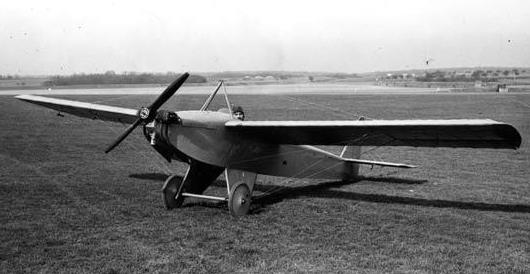
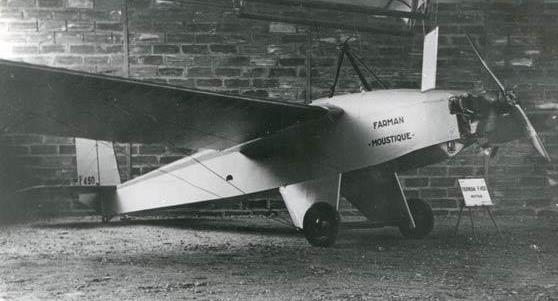
| Type |
Single seat sportplane |
| Engine |
1 Ava 4A-00 with a 2-bladed wooden Merville Srs 639 propeller |
| Dimensions |
Length 6,40 m , height 1,90 m , span 8,07 m , wing area 10,50 m , |
| Weights |
Empty 151 kg, loaded 285 kg , max. take off weight |
| Performance |
Max.. speed 130 km/h , cruising speed , range 350 km, endurance , service ceiling , climb |
| Type |
Werk.Nr |
Registration |
History |
|
7519.18 |
D-APJF |
The German civil register indicates the existence of a Farman aircraft, unspecified type, registered D-APJF. But the French register indicates that the F-APJF was Farman 451 No. 7519.18. So we can think that this plane could have been simply manipulated by a touch of paint to replace the letter "F" with a "D". This is however, an assumption that no document supports it. |



